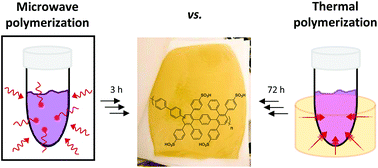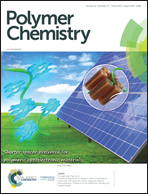Microwave-assisted Diels–Alder polycondensation of proton conducting poly(phenylene)s†
Abstract
An exploratory microwave-assisted synthesis of a promising proton-conducting, Diels–Alder poly(phenylene) is reported and comprehensively compared against a traditional, thermal polymerization approach. A 24-fold reduction in reaction time is achieved by microwave synthesis. Characterization of polymers prepared by microwave-assisted synthesis vs. the thermal approach reveals little difference in their physicochemical and solid state electrochemical properties. However, membranes cast from polymers prepared by microwave synthesis possess a 7.0% increase in tensile strength but 38.6% lower elongation at break, which may be due to an increase in the number of para–para linkages found along the polymer backbone. High ex situ proton conductivities, up to 186 mS cm−1 at 95% RH and 80 °C, are obtained for cast membranes. When assessed in situ as fuel cell membranes, the microwave-assisted polymer provided a similar maximum power density (1217 mW cm−2) to that prepared thermally (1206 mW cm−2). The consistency between the materials synthesized highlight the efficacy of microwave chemistry for rapid, scalable, and reproducible synthesis of advanced functional materials, such as proton-conducting Diels–Alder poly(phenylene)s.



 Please wait while we load your content...
Please wait while we load your content...